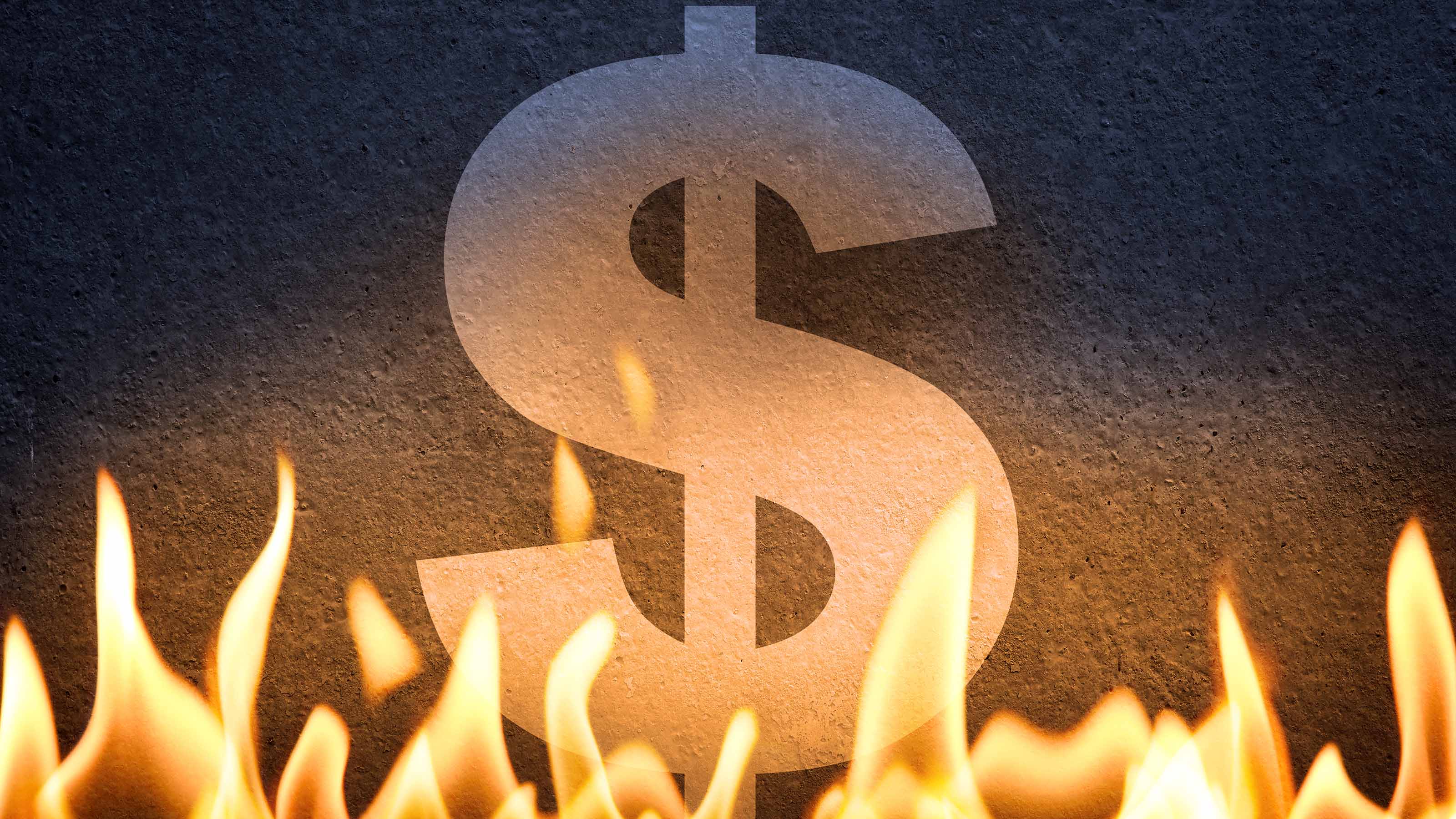
Inflation came in a little bit hotter than expected last month, the January Consumer Price Index (CPI) report revealed Tuesday, all but ensuring that the Federal Reserve won't enact as many interest rate cuts this year as the market had hoped.
Headline inflation rose 0.3% last month, the Bureau of Labor Statistics said Tuesday, while economists were looking for a 0.2% rise in the index. On an annual basis, headline inflation increased 3.1% vs expectations for 2.9%.
Core CPI, which strips out volatile food and energy costs, accelerated 0.4% last month vs a forecast for a 0.3% gain. For the trailing 12 months, core CPI rose 3.9% vs expectations for 3.7%.
Shelter, which accounts for about two-thirds of the CPI weighting and moves with a lag, was largely to blame for the nasty upside inflation surprise. However, January's inflation data is particularly tricky to forecast, experts note.
Either way, the Fed's rate-setting group known as the Federal Open Market Committee (FOMC) is looking for sustained evidence that inflation is whipped before it moves to cut interest rates from a 23-year high. And while the latest CPI report doesn't change the FOMC's calculus, experts say, it does put the final nail in the coffin for a rate cut at the next Fed meeting. May is looking less likely, too.
"Prior to the release, the fed fund futures market showed a 70% chance of a cut at or before the May 1 meeting," notes Paul Toft, senior portfolio manager at Key Private Bank. "Hopes are fading here, as futures immediately repriced the chance of a May cut to 40%."
Expectations that the Fed could enact as many as six cuts in 2024 helped the market rally hard into the end of last year. The latest inflation data take some of those cuts off the table.
With the January CPI report now a matter of record, we turned to economists, strategists and other experts for their thoughts on what the data means for markets, macroeconomics and monetary policy going forward. Please see a selection of their commentary, sometimes edited for brevity or clarity, below.
Expert takes on the CPI report

"Today's inflation report is a perfect example of why the Fed wanted to edge the markets off expecting a March cut. It's simply too early to be confident that the risk of economic overheating has moved into the rear-view mirror. On the face of it, this report is not what investors wanted or expected. Every single element of the Fed's most-watched 'super-core' inflation showed positive year-on-year changes. That said: where Fed policy is concerned, today's inflation data confirm our expectation that June is most likely the time for a Fed rate cut. As long as the unemployment rate is low – and it is currently quite low at 3.7% – the Fed can sit tight at higher policy rate levels and let firm inflation numbers like this play out." – Lauren Goodwin, economist and chief market strategist at New York Life Investments
"Housing costs contributed significantly to inflation and are reported with a lag, whereas real-time measures of rents have been declining. January can also be a difficult month to measure on a seasonal basis, as annual price increases can take effect at the beginning of the year. With that context, I wouldn't read too much into this one report. That said, this is a modestly negative report for the equity market. Chair Powell and other Fed members have made clear that a March rate cut was off the table and it's difficult to see a cut in May after this report. Summer cuts likely remain a possibility. While we're likely to see upward pressure on interest rates, those rates remain within the recent range and shouldn't upend the stock market." – David Royal, chief financial and investment officer at Thrivent
"We've made two steps forward in the fight against inflation, and now we take one step back. These numbers thwart some of the optimism about a May rate cut, but there's also a lot of noise from categories like auto insurance and rents. It gives investors reason to pause following the recent strong rally in stocks, but the damage could be limited given the potential for revisions." – David Russell, global head of market strategy at TradeStation
"An unpleasant surprise but not a game-changer, at all. We expect the downshift in core inflation to continue after this blip, tracking the normalization of leading indicators for rents, core goods prices, wages and margins. We're not at all surprised to see yields spiking after these data but the numbers don't change the big picture at all, and the back-up just sets the stage for a hefty rally over the next few months as it becomes clear that inflationary pressure is fading and, probably, the labor market is materially softening." – Ian Shepherdson, chief economist at Pantheon Macroeconomics
"While today's headline and core CPI readings certainly left plenty to be desired, a look under the hood confirms that the broader disinflationary trend remains intact. Shelter contributed over two-thirds of the last 12-month increase in core inflation, and looking at more real-time indicators, this component is widely expected to roll over at some point soon. The markets have spent the last month or so adjusting their rate cut expectations lower and are finally more closely aligned with central bank messaging. Given the virtual certainty that rates will remain unchanged at the FOMC meeting in March, markets now look forward to the May meeting, and the Fed will have plenty of time between now and then to assess inflation and consumer data before making any cuts." – Austin Schaul, head of research at Avantax
"These numbers support the Fed keeping rates higher for longer, as Chair Powell recently said he wanted to have more confidence that inflation was trending toward their long-term goal of 2% before cutting rates. Today's numbers did not provide that comfort. We remain aligned with the Fed's comments of being more cautious in when to start cutting rates, and we believe the first rate cut will not come until the June or July meeting." – Paul Toft, senior portfolio manager at Key Private Bank
"CPI was hotter than expected, but this is not entirely unusual for January given seasonal adjustments, and something we saw the past two Januarys. That said, this probably puts a final nail in the coffin for a March rate cut, and even makes May less likely." – Sonu Varghese, global macro strategist at Carson Group
"The CPI report for January came in somewhat hotter than expected and potentially could be a sign that inflation may be more persistent than observers have hoped. On the other hand, CPI overstates the role of housing in inflation. This is one reason the Fed prefers to look at PCE inflation over CPI inflation. If the PCE inflation report later this month is similarly hot, then the Fed may further delay cutting its interest rate target." – Patrick Horan, macroeconomist at the Mercatus Center
"January's CPI clearly throws a bucket of cold water on the disinflation narrative. Two things stand out. Shelter should not have turned around based on the leading trend of alternative rent data. We would have expected it to flatten out later in the year. It could be a sample anomaly, or it could be something more ominous. Second, disinflation failed to 'broaden' as a number of core services showed an instantaneous re-acceleration. Today's reading calls into question Chairman Powell's premature victory lap in November and December. There was simply no need to reanimate the markets. More recently the FOMC tried to walk it back with the 'build confidence' meme. By then, however, the horse had already bolted. It was a poor risk management decision that is coming home to roost." – Brad Conger, chief investment officer at Hirtle Callaghan & Co.
"January typically has some distortions in the economic data and as such, economists may be more interested in the future revisions to this report. Although this data is hotter than expected, the overall trend is that inflation has been decreasing and it is expected to continue. Data trends typically are non-linear, and this tick upward could raise the eyebrows of the Fed but will probably not deter them in their continued fight against inflation. Although 'higher for longer' has been the consensus regarding interest rates, a rate cut in the second half of 2024 is not off the table." – Robert Conzo, CEO and managing director at The Wealth Alliance
"Headline inflation over the previous 12 months declined in January although monthly prices came in a little higher than expected. A combination of lagging indicator for rent and high price increase for lodging away from home led to a large increase in shelter price contributing for two-thirds of the overall monthly increase in prices. Energy and commodity prices continued their decline for several months in a row. Inflation is heading in the right direction but the Federal Reserve needs more data points to change policy direction with confidence." – Dawit Kebede, senior economist at America's Credit Union
"Investors know that January CPI prints can be noisy due to potential seasonality. However, today's headline and core CPI print were well above expectations. Chair Powell outlined two criteria for building the Fed's confidence to begin cutting rates: 'not better data, but continuation of good data' and a 'broadening' of disinflation. In our view, today’s data met neither criterion with the dynamic between goods and services looking worse, not better. That said, a lot of the upside risk to a hotter than expected inflation print was already traded in the market post the January FOMC meeting, as we were only looking at close to four to five cuts this year." – Alexandra Wilson-Elizondo, co-chief investment officer of the multi-asset solutions business in Goldman Sachs Asset Management
"Today's hotter print was the final nail in the coffin for the prospect of a March rate cut and will likely lead to renewed debate around a 'no landing' or overheating scenario. The disinflation process is not a straight line, however, and one hot print on its own after an extended string of more favorable releases does not represent a new trend. Fed fund futures are now pricing less than a 50% chance of a May rate cut, with the first cut fully priced in June and 3.8 cuts total in 2024. While the market is moving toward the Fed dots, we believe that a May rate cut is still a possibility given the incrementally better read-through to core PCE as opposed to the less favorable headline CPI figures. Good news is once again bad news, but through the last several years the upside to earnings that accompanies hotter inflation has more than overwhelmed the headwinds to valuations from higher interest rates as evidenced by US equities trading near all-time highs." – Josh Jamner, investment strategy analyst at ClearBridge Investments







